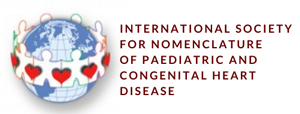Originally named The International Nomenclature Committee for Paediatric and Congenital Heart Disease, The ISNPCHD was formed in Frankfurt, Germany in October 2005 to explore the possibility of establishing a common international system of nomenclature for congenital heart disease. The Nomenclature Committee was established after the near-simultaneous publication of two complementary systems of nomenclature for congenital cardiac malformations and their procedure-based treatments in early 2000:
- The European Paediatric Cardiac Code (EPCC) of the Association for European Paediatric Cardiology (AEPC).
- The nomenclature of the International Congenital Heart Surgery Nomenclature and Database Project of the Society of Thoracic Surgeons (STS).
This led to the problematic situation of having two lexicons that were to be widely adopted, with the potential risks of invalidating multi-center projects due to confusion between the two systems and duplicate or inaccurate entries within institutions. Both systems of nomenclature followed the same basic structure:
- A comprehensive Long List (thousands of terms) / A Short List (~650 terms), designed to be used as part of a minimum dataset/ Long Lists mapped fully to the Short Lists
The Frankfurt meeting of interested parties led to an agreement to establish the Nomenclature Committee with an aim to produce a bidirectional map between the two systems. This work was then presented and endorsed at the Third World Congress of Pediatric Cardiology and Cardiac Surgery in Toronto, Canada on May 27, 2001, during the First International Summit on Nomenclature for Congenital Heart Disease. The ISNPCHD’s first committee, The International Working Group for Mapping and Coding of Nomenclatures for Paediatric and Congenital Heart Disease, (the Nomenclature Working Group (NWG), was founded in 2001 after the First International Summit in Toronto. The NWG’s mandate was to develop a common nomenclature for congenital heart disease that could satisfy the needs of all professionals interested in the field. This comprehensive list, called the International Paediatric and Congenital Cardiac Code (IPCCC), could be used to promote data collection and research throughout the world. To develop the IPCCC, the NWG worked for the next decade to crossmap the two pre-existing comprehensive lists of terms that had been published in 2000. While English is the official language of the IPCCC, for ease of translation an alpha-numeric backbone to the IPCCC was considered essential. Combining the 6-digit alpha-numeric codes associated with each of the items of the European Paediatric Cardiac Code (EPCC) with additional codes for the IPCCC’s complete list, all of the more than 10,000 entries of the IPCCC were matched to alpha-numeric codes. On September 19, 2005, the Nomenclature Working Group was able to report to the Second International Summit on Nomenclature for Congenital Heart Disease at the Fourth World Congress in Buenos Aires, Argentina, that they had succeeded in crossmapping the majority of congenital cardiac lesions. Subsequent meetings of the NWG in 2006 and 2007 expanded the IPCCC further to cover fetal cardiology, arrhythmias, congenital coronary arterial anomalies, echocardiography, and interventional cardiology procedures. As of early 2013, there were 12,168 items in the IPCCC version derived from the European Paediatric Cardiac Code, and 17,176 in the IPCCC version derived from the International Congenital Heart Surgery and Nomenclature Database Project, with an additional hundreds of qualifiers.
